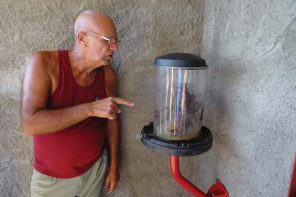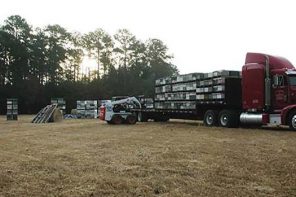By: James E. Tew
For the moment – success!
No doubt, I told you about my experiences last Autumn. I simply can’t recall how much I wrote. True, I could look that up, but I have a story I want to tell you; and either way, I will need to retell parts of the past saga. The shortened version of my story was that last Fall, I had to address some “addressable” health issues. A surgical procedure was required, and an unexpected hospital stay was included. Recovery took longer than expected, and I was forced to take an objective look at my ever-increasing age. I’m good now.
During that time, my bees had to take care of themselves. Has Jim Tew not often said that the yard most distant from him and his colony management programs usually fare the best? Disappointingly and bluntly written, my bees, in fact, last winter did not do a superb job without me. Indeed, many of my colonies died last Winter.
Personal observation made over the wintering seasons – Most likely due to the effects and side-effects of the Varroa infestations, a large adult bee population and a large honey reserve will not guarantee my colonies’ unquestioned wintering success. Beautiful colonies can still die and ugly winter death. I am near the point of making a profound statement that, for successful wintering, colony health is more important than sufficient food reserves. I can supply emergency food, but I can do little about bad health in a wintering cluster.
As has been the case in other instances, these dead colonies left significant amounts of unused honey stores. In other articles, I have made light of the process of taking surplus honey from dead colonies – Sardonic humor. Once again, I had significant quantities of honey from winter-killed colonies that was not pristine.
This honey was really not pristine. You will see no photos – no videos – of this crop in this article. Too many of you would be offended. The options for solving this unloved honey issue and returning the committed equipment to usable condition would drain the remainder of my article space here. With honey bee package delivery imminent and hive equipment in short supply, I opted to work side-by-side with my bees. In my own non-verbal way, I asked the bees what they could do with this messy crop.
As best I could, I cleaned the frames, full combs, and hive equipment. In the traditional manner, I installed the packages and ultimately released the queens. At the time of package installation, I gave each of the packages two deep frames of the sullied honey.
As was my plan, I checked all the packages the next day. With bated breath and minimal smoke, I was elated to find that a minor miracle had occurred. Overnight, the bees had cleaned and reclaimed the two frames to the extent that they looked (mostly) like typical honey frames. As the following days/weeks passed, as needed and when possible, I continued to add blemished honey frames to the ever-growing bee population. In my defense, I never once overwhelmed them with this ugly task. I added frames slowly and over time.
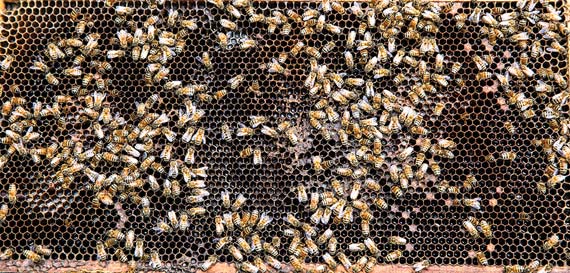
This frame had mostly crystallized honey. (Lower left remains.) Bees have moved reprocessed stores to right side. Brood nest area is being repaired. New white wax on some edges. Punctured cappings are on honey – not brood. 50% of the bees have been removed to show the comb.
A needed clue – Not really knowing how the bees would react to these needful honey frames, I put an outer cover (topside up) underneath the colony and monitored the trash accumulation from the frames being refurbished. All hives opened screened bottom boards. No trash would equal no interest in the frames. Immediate trash and steady trash accumulation would man reclamation work was underway. In general, monitoring the colony trash both in front and beneath the colony is a good monitoring procedure. Good information can be gleaned from bee colony garbage.
Massive colonies
These three-pound packages have developed into massive colonies; beyond anything for which I could have hoped. I must give the queens a lot of credit. No colony growth could have occurred without solid queen performance. Of the 10 packages with which I began, two queens were rejected. One was replaced naturally, and I simply combined the other package into a six-pound package.
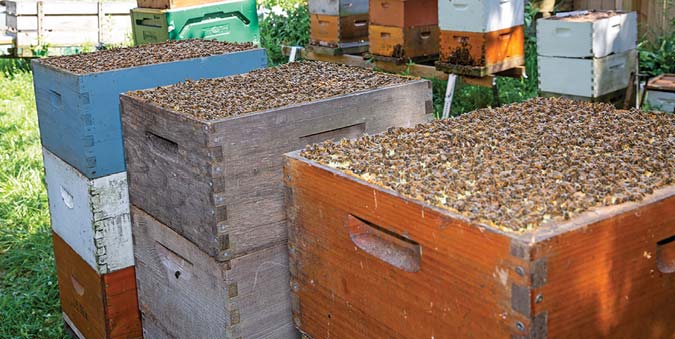
In three months, from a three-pound package to these powerhouse colonies in three deeps. I have since added another deep to all colonies.
Random thoughts and admonishments
Yes, the honey I gave the packages was ugly. There is simply no other word other than ugly that could have described it. But it was naturally bee-processed honey in natural wax combs. It would appear (I have no science to support my conjecture) that usable honey that needs recovering is more beneficial than a sugar syrup feed that bees must process and then build combs in which to store it. Again, it would appear that the bees professionally cleaned the product and immediately began to put it to use. If I dare write this for you, I cautiously say that these colonies are too large too fast.
They’re going to swarm. I can nearly promise you that I will get either off-season or late season swarms from these big colonies. I have learned this from painful experience. In seasons past, from colonies this size, I have had to watch large primary swarms along with my beautiful marked queen, fly away. I don’t care how long you have kept bees, or how it could be beneficial to the environment – a large swarm flying away is painful.
Personal experience gained from painful experience – A beautiful colony will not stay beautiful indefinitely. Truly, in this case, beauty is in the eye of the beekeeper beholder. Such colonies are unnatural, and the bees, given time, will make corrective changes – or something else will change. The season will pass. Varroa populations will grow. Suicide swarms will issue too late to establish themselves. Robbing. Beauty in bee colonies waxes and wanes. Enjoy them while they last. Make photos. Boast.
I’m going to split them later this week. I have arranged to get quality mature cells that I will use to help speed the queen replacement process along. Colonies like I am picturing here are unnatural in the wild. If it works, I will keep you informed.
I have had colonies that looked this good before. Keeping colonies this large is hard work. It is as simple as that. They are crazy heavy. They can be defensive. They are difficult and messy to work, and they are hard to treat for mites–but I wish all of my colonies were like this.
Was Ozymandias a beekeeper?
My name is Ozymandias, king of kings:
Look on my works, ye Mighty, and despair!’
Nothing beside remains. Round the decay
Of that colossal wreck, boundless and bare
The lone and level sands stretch far away.
Am I in any way like Ozymandias? Did I not start this season with honey stores from Winter-killed colonies? Was my apiary not laid to waste during the past winter? Did I not have nice colonies last Summer with which I fretted and wrote articles? Did I not struggle to control varroa populations last season and all the seasons before? I must not forget that my unique success story this season is built on last Winter’s killed colonies. One seasonal colony empire seems to build upon the previous one.
My bees are great just now. I don’t get to say that very often. It feels good. But from years of experience, I know that this beautiful moment cannot last. I plan to photograph and enjoy, but then I must do what I must to keep them with me and not off in the wild – or worse.
Yet some other pleasant surprises
Late during the spring of 2019, I had a few remaining Ohio wildflower seed packets that I scattered in a small plot in front of my shop. Last Spring (2019), a few scruffy plants came up and put out a few desperate flowers. All the plants soon gave it up for the Winter. I thought no more about them.
The past Winter was mild with only a few truly cold periods. Not much snow. Occasionally, I would notice that the dormant native plants in the small plot did not appear to have been cold killed. Otherwise, I did nothing. This past spring, 2020, that little planting exploded. Presently, I actually look like a flower gardener, but in reality, all I did was sow a few seeds and lightly cover them with a shallow layer of mulch and then wait a year. I have been given compliments, and I have greatly enjoyed the native bee activity on the blooms.

This small garden germinated from volunteer seed from the previous season. I had to support the spindly plants from falling over. Native bees and Syrphid flies love this little planting.
When gardening, I don’t know what I am doing. I only garden enough to subsidize my bees, but I have always had an interest in both flower and vegetable gardening. My parents and grandparents seriously gardened. I grew up with both flower beds and large garden plots, but I have not always followed through as an adult (read that to mean that I have grown a lot of undesirable weeds in my time).
I am not enough of an accomplished writer to express what I would like to say. My feeble effort would be that flower gardening is not beekeeping, but flower gardening is very closely allied to beekeeping. While I realize that I cannot plant enough to have any true positive effects on my bees, I still feel good about trying.
I let my lawn run wild, too.
My neighbors have grown accustomed to this lawn quirk of mine. For many seasons now past, I have stopped mowing my back lawn during clover season. I make no effort to eradicate “weedy” white clover. On either side of me, lawns are regularly manicured and trimmed.
I have written in past articles that there are some undesirable aspects of lawn wildness. I suspect I have more than my share of Japanese beetles, but that’s okay. I also have more than my share of butterflies and pollinators. But I have more than my share of mice and moles, but that’s okay, too. I commonly get rabbits and ground hogs too. But this season, I had a special visitor in response to my unmanaged lawn – a red tail hawk.
The majestic bird spent the morning in my back yard – apparently hunting for food in the nearly knee-deep clover and grass of my backyard. I actually limited my activities and stayed quiet – for hours – in order not to disturb the bird as it surveyed and hunted the area. On occasion it would swoop down to the grassy ground to take care of some business.
At one point, the predator bird and a squirrel had a near-confrontation that I was allowed to watch. I did not become involved. Ultimately, the squirrel opted to just wait the bird out. Both, apparently, lived happily ever after.
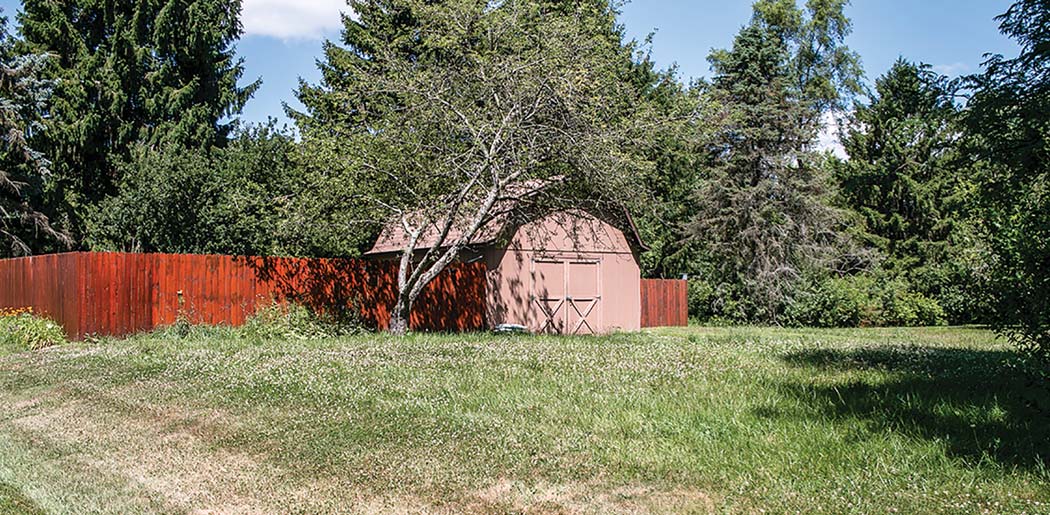
Season clover that I leave for my bees and anything else that wants to be there.
Beekeepers, I must say that it was an interesting moment. I realized that my initial effort to provide a small amount of forage for my bees had allowed cover for other smaller animals which had, in turn, allowed larger predaceous animals to prey on the smaller ones. For a brief moment, I had developed a multi-tiered environment – all because I wanted to allow my bees some forage. It felt good.
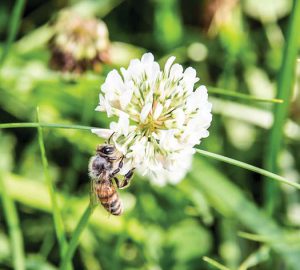
One of my bees on a clover source that I provided. Good job, Jim.
Summer smells
One of the losses of written matter is the loss of all things with an odor. The clover and my small native flower garden all have a very pleasant aroma. Then there’s my beeyard. I have often thought how much information that I associate with apicultural odors. Yet, I have never experienced a single lecture that could capture the cacophony of odors that come with bee management.
Just now, within my apiary is the gentle odor of nectar being processed. A few days ago, while in a frenzy to get extra equipment ready for placing on the hives, I removed some wax moth damage. Wax moth damaged combs have a unique odor. Smoke from my hive smoker leaves a residue that smells of both new and old smoke. The odor of the alarm pheromone is emitted when I am stung. The straw odor of package bees in my car as I drive home from picking them up agitates my allergies.
New beekeepers, all I can say on this topic is that there is a world of bee-related odors that you will have to discover for yourself. I can show photos and movies, but I cannot capture the associated smells that go with our beekeeping.
I have nearly missed my mark in this article. My inspiration for the month was to be a review of the backyard environmental complexity related to beekeeping. This includes the interaction of other life forms in that system and the odors that are related to beekeeping.
For the past few weeks, I have deeply enjoyed diversity that has been associated with my beekeeping. Honey bees and their management are always part of a much more complex picture. For me, that picture is frequently out-of-focus. For the past few weeks, I was allowed a glimpse of that bigger picture. It was a good experience. Keeping bees is so much more than simply keeping bees. I thank you for reading this piece.
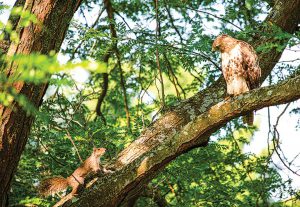
Two animals sizing each other up. They ultimately came together due to my unkempt back lawn. Both survived the encounter.
Dr. James E. Tew, Emeritus Faculty, Entomology, The Ohio State University and One Tew Bee, LLC; tewbee2@gmail.com; http://www.onetew.com.







